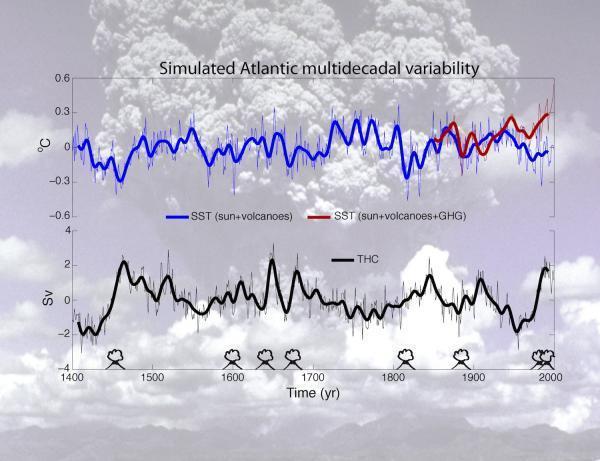
© University of BergenThe upper panel shows the variations in North Atlantic Ocean basin wide sea surface temperatures in a simulation that includes historical variations in total solar irradiance and volcanic aerosols (blue), and in a simulation that in addition to the natural external 'forcings' also include anthropogenic 'forcings' for the last 150 years (red). Up to year 1900, the blue curve is consistent with available temperature observations, whereas only the red curve matches the observed temperature evolution in the 20th century. The lower panel shows variations in the large-scale ocean circulation in the Atlantic (black) and dates of major volcanic eruptions.
A study presented in
Nature Geoscience suggests that changes in solar intensity and volcanic eruptions act as a metronome for temperature variations in the North Atlantic climate.
A research team from the Bjerknes Centre for Climate Research in Bergen, Norway, has studied the climate in the North Atlantic region over the past 600 years using the Bergen Climate Model and the observed temperature evolution. They point to changes in the solar intensity and explosive volcanic eruptions as important causes for climate variations in the North Atlantic during this period.
The Sun, Volcanoes or Ocean Currents?The traditional and common view is that climate variations in the North Atlantic lasting a decade and more, is governed by changes in the large-scale ocean circulation. The presented analysis supports this common perception, but only when the climate effects from changes in the solar intensity and volcanic eruptions are left out.
When the scientists include actual changes in the solar forcing and the climate effect of volcanic eruptions in their model, they find a strong causal link between these external factors and variations in the Atlantic surface temperature. In particular, the study highlights volcanic eruptions as important for long-term variations in the Atlantic climate both through their strong cooling effect, but also through their direct impact on atmosphere and ocean circulation.



